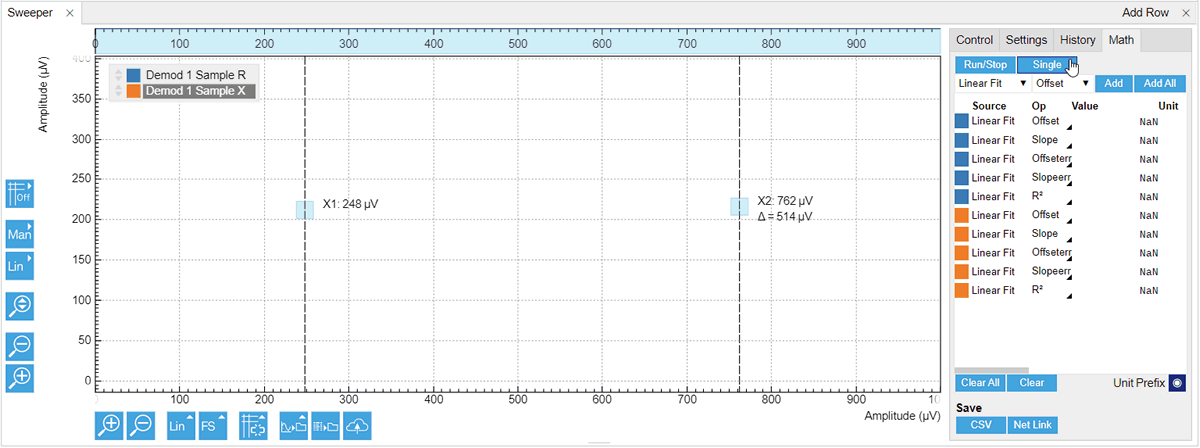
All Instruments Powered by LabOne
Quantum Computing Control System
-
Compact and scalable to more than 100 qubits
-
Productivity-boosting LabOne® software
-
Low noise, high resolution and large bandwidth
-
Fast and flexible quantum feedback
Lock-in Amplifiers
-
Instruments from DC to 8.5 GHz
-
Low input noise, high dynamic reserve
-
Tools including boxcar, PID, scope and FFT
Impedance Analyzers
-
1 mHz to 5 MHz, 1 mΩ to 1 TΩ
-
Measure fast and accurately
-
Ideal fit for DLTS, MEMS and ESR & ESL measurements
Powerful User Interface

LabOne® stands as a high-quality user interface for an outstanding user experience, as it incorporates advanced instrumentation and flexible software architecture.
A configurable environment
-
Data capture with one mouse click onto local or remote storage
-
Iterative optimization of measurement parameters thanks to integrated tuning features
-
Real-time data analysis on still images through cursor control
-
Plot acquisition as PNG, SVG and CSV files
-
Offline access to measurements and data acquisitions
LabOne – Instrument Control Software
LabOne® stands for platform-independent instrument control with proven measurement methodologies. The browser-based user interface comes with an outstanding toolset for time- and frequency-domain analysis as well as sophisticated support to set up control loops, perform noise measurements, and interpret measurement data. Interfaces to the most popular programming languages are also available.
The computer is the cockpit
Software-driven instruments present many advantages compared to instruments with arrays of buttons on their front panels. Buttons are easy to use, but they do not facilitate instrument reconfiguration. Integrated touch screens can provide a somewhat improved user experience, and yet they generally lack resolution.
The test and measurement industry has been moving towards larger screens and fewer buttons on the instrument's front panel. With the LabOne user interface, Zurich Instruments omits buttons entirely and supports multi-screen, feature-rich operation with full computer control.
MFLI 500 kHz / 5 MHz Lockin Amplifier
LabOne® is the instrument control software enabling efficient workflows for simple and complex experiments thanks to
-
Browser-based user interface with support for common programming languages
-
Advanced signal processing tools for time- and frequency-domain data analysis - Multi-channel signal acquisition across multiple instruments in real time
-
Excited to help you with your signal processing needs

Zurich Instruments offers lock-in amplifiers for every frequency range up to 8.5 GHz. Each instrument is equipped with the control software LabOne®. In addition, a range of upgrade options fulfill the requirements of the most demanding applications.
Lockin Amplifiers
Lock-in amplifiers play a crucial role in research labs specializing in optics, photonics, nanotechnology, materials science, quantum technologies, scanning probe microscopy, and sensing. These amplifiers can detect small signals hidden in noise, enabling scientists to discover new science and broaden the scope of their experiments. The lock-in amplifier works by mixing the measured signal with a reference frequency and then filtering it through a low-pass filter, a process known as demodulation or phase-sensitive detection.
MFLI 500 kHz / 5 MHz Lockin Amplifier and Impedance Analyzer



HF2LI 50 MHz Lockin Amplifier



Key Features
-
Measure from DC to 50 MHz
-
Precisely measure two differential voltage signals
-
Demodulate up to 6 harmonics simultaneously
-
Fast measurement time and low noise floor
-
Configurability with multiple auxiliary input/outputs
-
LabOne® toolset including Scope, Sweeper, and Spectrum Analyzer
-
Expand your toolset with upgrade options
UHFLI 600 MHz Lock-in Amplifier








